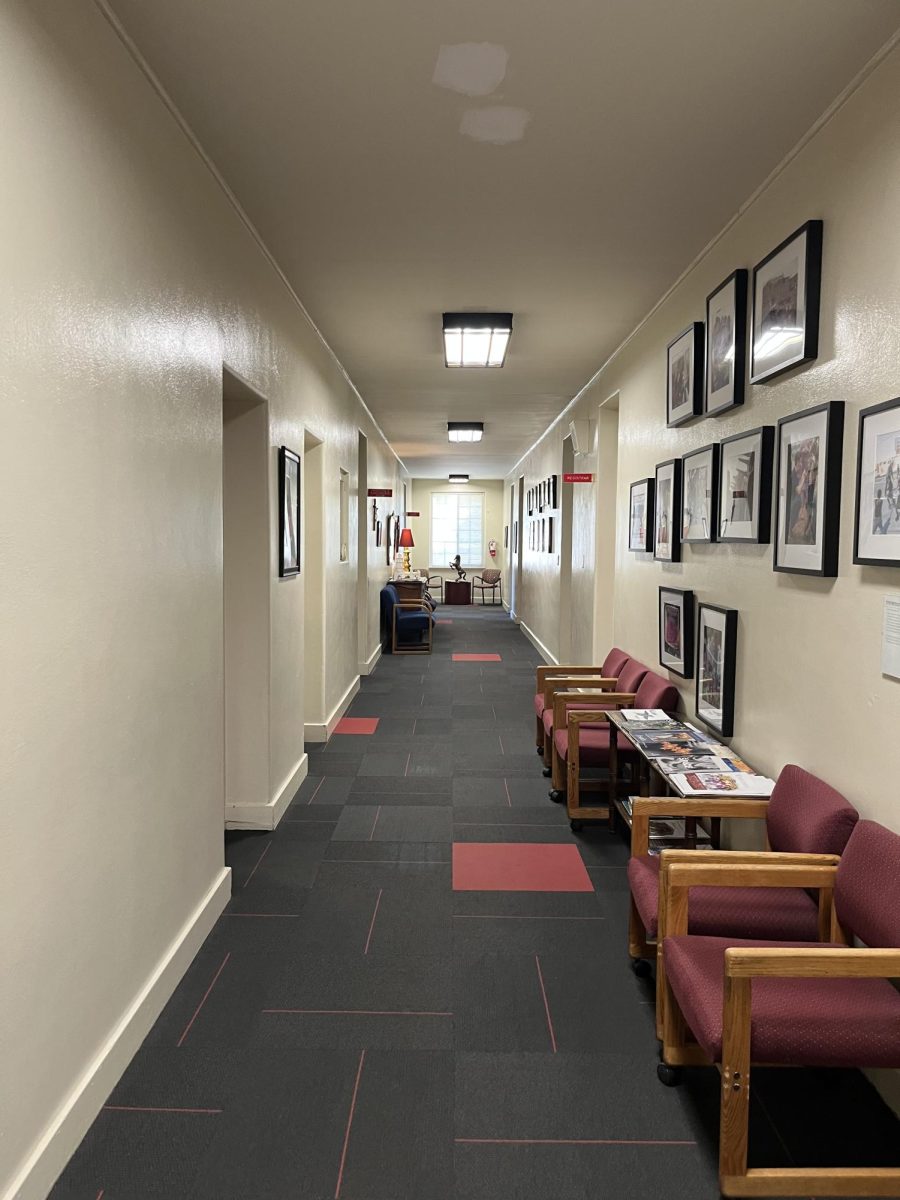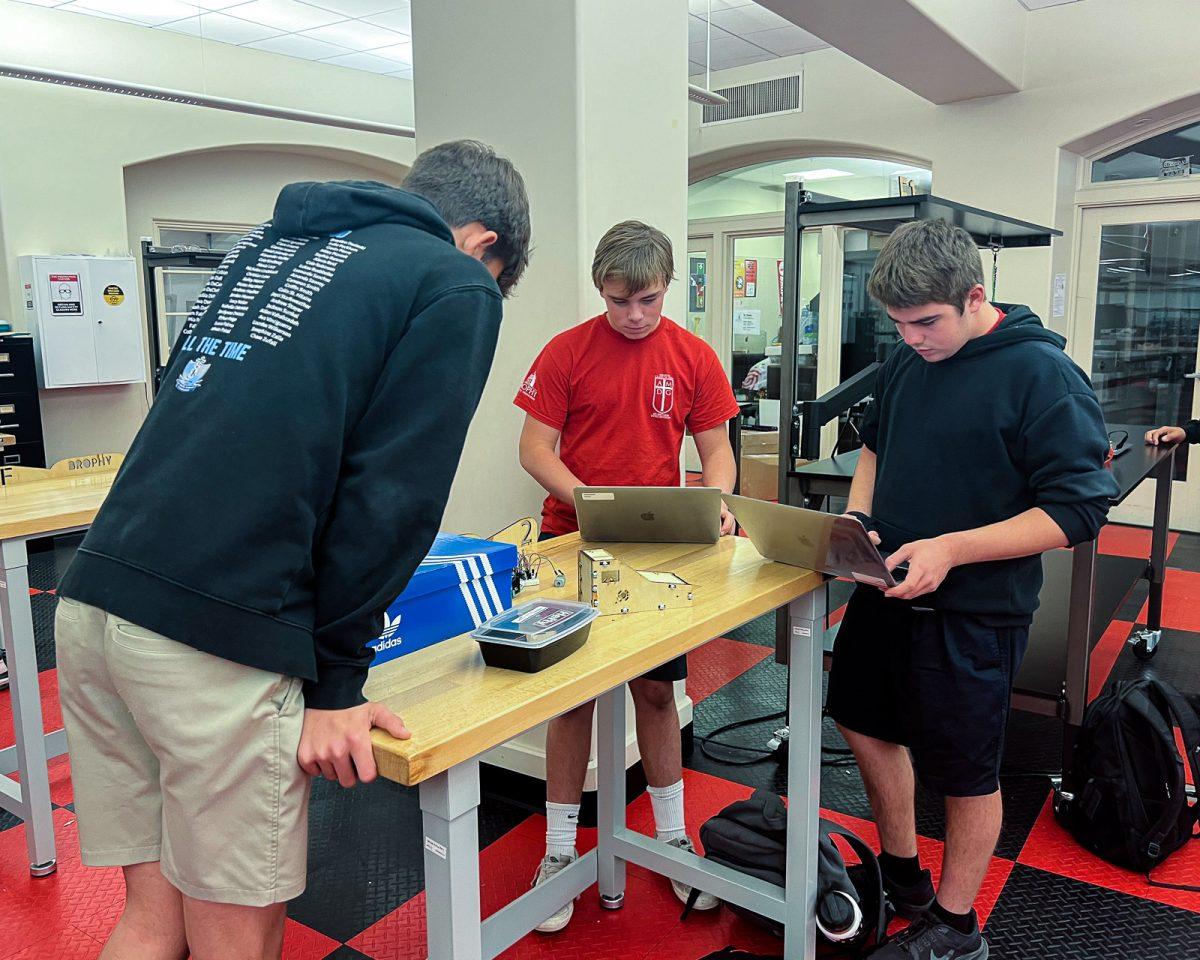Photo by: Jackson Stack ’25
Donavan Dalley ’26 and Ronnie Broatch ’26 work diligently on designing their first prototype during Intro to Tech class. Noah Donavan joins Broatch in learning how to make a wooden car from scratch using an online cad.
The Information Commons was remodeled into the Innovation Commons during the 2015-2016 school year, which brought industrial machines onto campus and transformed learning.
The Information Commons was originally a library that had six computers in total, where students could complete homework online and check out books needed for class. As Brophy got more and more technologically advanced, the need for a library was obsolete. Instead of having a computer lab that houses six computers for 1,200 students, Later Brophy converted to 1:1 technology integration, where every student would have access to the internet.
Now, books and projects are available through the MacBooks, yet most of the technological advances are in the Innovation Commons. In the IC, there is a multitude of computers, 3D printing machines, CNC routers, plasma cutters and water jets which students use all day long.
Intro to Technology is the only required class for students in the IC. The other 2 classes are electives one can take to continue interest in technology. In Intro to Tech students do not use industrial machines that work with metal like water jets or plasma cutters, which limits their usage. Plasma cutters and water jets can both cost anywhere from $10,000 to $175,000.
In contrast, the 3D printers and the laser cutters are always in use by the Intro to Tech class which can cost anywhere from $200 to $3,000. The usage of these machines is limited by the amount of experience you have, which comes from the courses you take. For example, to get into the engineering elective class which works with the water jets and plasma cutters, you need to complete both Intro to Innovative Technology and Advanced Technology. This can cause more students to lose interest in technology because of what is required to work up to the expensive machines.
It is important to note that Brophy received two major grants which allowed the purchasing of more expensive machines.
One of which was given in 2015 by the Virginia G. Piper Charitable Trust and awarded $4.75 million to renovate the Information Commons, buy machines and buy needed materials like filament and wood.
The first machines they bought were the 3D printers, laser cutters and normal printers. The second grant, from the E.L. Wiegand Foundation, was awarded last year and was used to buy the plasma cutter and the water jet.
Assistant Principal of Technologies Mr. Mica Mulloy ’99 said, “All the tools across the board are getting used quite a bit.” This means that the machines are all being used, but there is room for more use, especially for the upper-level machines that the IC houses.
“I would say that most of the equipment is used most of the time,” said Mr. Mulloy, “students are coming down to work on other projects or just for fun.”
An example of a young creator at Brophy is Bremer Kaprosy ’25. He spends 10 hours a week just in the IC alone compared to 26 hours of normal classes we have every week, which means 38% of his week is spent in the IC. When he goes down there, he works on leading his rocketry club and manufacturing and designing the Speech and Debate Trophies.
Kaprosy also took the idea of creating something new with STEM to a whole new level, especially with his projects. This year in Dec, Kaprosy and his club members will be the largest group of students to earn a High Power Rocket Certification and launch these high-powered rockets.
Kaprosy said that if more students understood what they could make in the space, more students would be down there from time to time. He explained that there is no incentive to go down there unless you have a class, which limits traffic.
“Giving access to kids’ industrial tools is unparalleled, and as kids learn what they can make down here, there will be more involvement,” said Kaprosy. What students may fail to realize is that most of Brophy’s trophies and projects around campus come from that basement space.
When students have a maker space like the Innovation Commons, the point of the space is to support students but without involvement, the IC cannot support students.
Some students have strong emotions towards the Innovation Commons because of Intro to Technology. Kalei’o Hernandez ’23 said, “As a freshman and sophomore you hate the IC, but when you get to Junior year you learn to appreciate it more.” There are benefits to having the IC and the tools down there, but the issue is that Intro to Tech. is a disincentive to discovery and creativity.
When students are forced to take a class, there is a lack of ‘the want’ to learn. According to Psychologist Peter Gray Ph.D., from Psychology Today, “When children are free—as I have observed at the Sudbury Valley School and others have observed with unschoolers—they take new, diverse, and unpredicted paths. They develop passionate interests, work diligently to become experts in the realms that fascinate them, and then find ways of making a living by pursuing their interests.”
When you do not have set boundaries and students are able to roam freely in their academic careers, the student is able to connect more with the material and pursue their interests.
Peter Gray Ph.D. said, “Students forced through the standard curriculum have much less time to pursue their own interests,” There is a discrepancy between Brophy’s academic mission and what students do. Lukas Villela ’25 had a negative experience in the IC during his Intro to Technology class because of the difficult projects you complete during Freshman year. Villela has not visited the IC since last year.
The issue is not the funding or the usage of the tools down in the IC, it is the lack of support it gets from the student body. There are many ways to get involved, and the IC is a great tool that should be used at least once a week.













